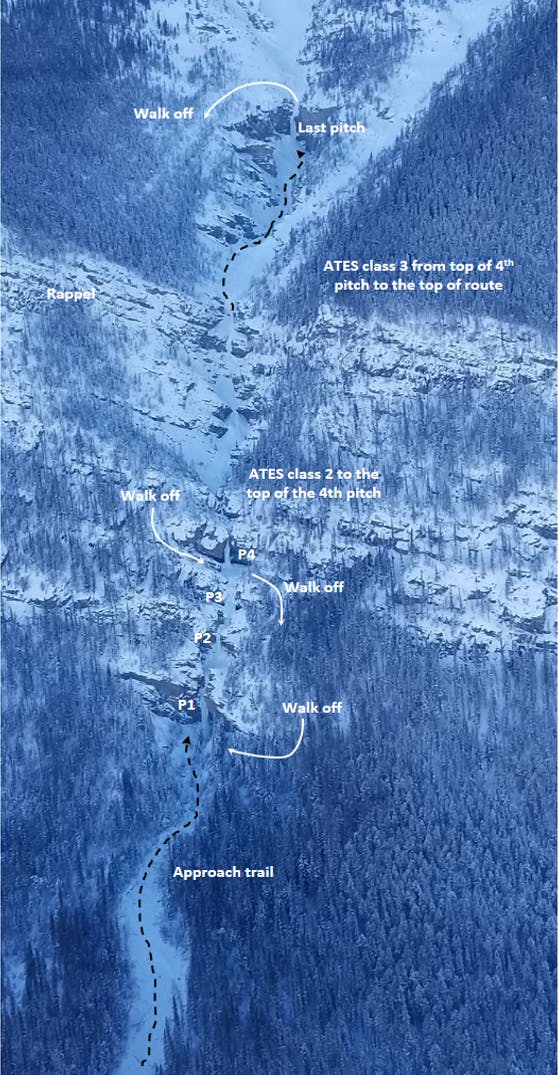Mt. Rundle
280M WI 4
ATES 2 (challenging) to top of third tier/fourth bolted station
ATES 3 (complex) above fourth bolted station
First climbed in 1974, Professor Falls can be easily seen from Highway 1. It is approached from the Banff town site by either a bike ride or a 1.5-hour walk. It consists of several tiers of short steep pillars and curtains, and culminates in a crux WI4 pitch at the very end. It consists of eight steps, which allows many parties to climb the route at the same time relatively safely. On busy days the route sees multiple ascents. All the stations have bolted anchors and the route can be rappelled. A walk-off in the trees on climbers left with a short rappel is possible too. Professor Falls can also be used to approach the Trophy wall and Sacre Bleu.
Professor Falls sits in the Professor avalanche path. This path is capable of producing avalanches that go right down to the river.

- Crédit
- Grant Statham
Popularity
- 109 people completed the survey
- 56% climbed it 1–5 times
- 16% climbed it 6–10 times
- 28% climbed it over 10 times
Avalanche frequency
- 84% have seen avalanche debris on route
- 21% have witnessed an avalanche in the area
Time of year and day
- February to April saw the greatest number of ascents and debris, then December to January, and lastly October–November
- 64% of avalanches witnessed occurred from 12–6 p.m.
- 36% occurred from 6 a.m. to 12 p.m.
Avalanche start zone
- 55% of respondents believe the avalanche started well above the climb
- 12% of respondents believe the avalanche started from the feeder gully before the last pitch
- 15% of respondents believe the avalanche started from above the last pitch
- 18% of respondents did not know where the avalanche started
Several start zones lie above the Professor Falls climb.

Run-out debris
- 68 people witnessed debris between the last and the second-last pitch
- 51 people witnessed debris between some of the middle pitches
- 28 people witnessed debris at the base of the first pitch and below
Seventy responses described runout distances and amounts. Very large amounts of debris have been witnessed at all lengths of the climb, and all the way down the approach path to the river. Debris almost buried the entire first pitch, and left little to be climbed for the last pitch. Depths were described as “30 ft”, “7 m”, and “mind-boggling amounts.” See below for descriptions.
Reported avalanches and incidents
- Critically buried between the second-last pitch and the last pitch but was dug out by partner using their helmet.
- We just approached the final pitch when a size 3 avalanche released from the bowl above the large cliff above the climb. More or less by chance, we could hide on the side of the gully while the avalanche flowed past us, piling up metres of snow right next to us.
- After pulling over on the second-last pitch, I noticed very heavy winds. Walking up to the last pitch, I noticed significant sluffing. While setting up, we heard a large crack from the trees above on climbers right. A few seconds later, some very large chunks of snow came flying down. We took cover on the climbers-right rock wall. The avalanche was probably a size 1–1.5.
- A size 0.5, maybe close to a 1, came down on me and two others on the last pitch. There was a loud crack followed by a minor flow of snow on the pitch itself and a few large blocks launching off the cliff climbers-right.
- We finished the route early. There was wind transport on ridgetop all day. When driving back to Canmore, we witnessed a large slide. The powder cloud went over the river.
- It was a warm end-of-season climb. We were a bit caught off guard that there was that much snow still above. The slide never got to us at the start of the last pitch, but the cornice failure gave us cause to abandon the climb and rap out.
- I have seen debris piled up at the base of the last pitch many times. I once found a nice new rope cut and sticking out of the debris at the base of the last pitch, so I dug it out and had a nice 40 m chunk. Someone had a close call.
- Several people noted witnessing large avalanches from the highway and other areas flow over Professors and all the way to the river.

- Crédit
- Grant Statham
A closer look at Professor Falls showing the approach route, pitches, and walk off route.
Contributing factors
- Winds: 59%
- New snow: 53%
- Warming: 44%
- Known weak layer: 18%
- Cornice or human/animal trigger: 12%
Summary
- Most people expect that there is greater avalanche hazard between the second-to-last and the last pitch than the rest of the climb due to the stepped nature of the lower part of the route.
- A surprising amount of people have witnessed debris throughout the middle pitches of the climb, and many all the way to the base of the climb as far as the river.
- Avalanches have run from early season (November) to late season (April/May), and greatly change the characteristics of the climb and the pitches.
- The last pitch has been buried, leaving only 10m of climbing, indicating the terrain above the last pitch is also a concern.
- There is a walkaround for descent that could limit exposure, with some potential for human triggering in some areas of the walk-off.
- Lineups and crowds can greatly increase the time one spends on this climb.